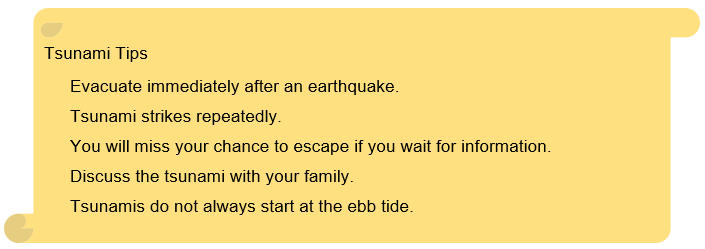
Disaster Management Manual
A manual for practitioners and decision makers!

Disaster Management Manual
A manual for practitioners and decision makers!
Tsunamis are caused by the uplift and subsidence of the seabed caused by earthquakes, and the upward and downward movement of seawater in the surrounding area. Because tsunamis move all the seawater from the sea bed to the sea surface, and because their wavelengths are very long, ranging from several kilometers to several hundred kilometers, the seawater becomes a huge mass of water that rushes to the coast 1.
The speed of a tsunami depends on the depth of the water it’s traveling through. The deeper the water, the faster the tsunami. In the deep ocean, tsunamis are barely noticeable, but they can move as fast as a jet plane, more than 500 mph (800 km/h). As they enter shallow water near land, they slow to approximately 20 mph (36 km/h), which is still faster than a person can run.
As tsunamis slow down, they grow in height. When they arrive on shore, most are less than 10 feet (3 m) high. In extreme cases, they can exceed 100 feet (30 m) when they strike near their source. Large tsunamis can flood low-lying coastal areas more than a mile inland 2.
Figure 4.4.6.1 2 shows an illustration of the relation between tsunami height and speed.

As in any other disaster, self-help is the most important way to protect yourself from tsunami. It is essential to know how each individual should act to protect his or her own life from a tsunami, especially a nearshore tsunami.
Table 4.4.6.2 shows the very important tsunami tips developed in Kushimoto-town 3.

When in a low elevation area, it is important to be aware of tsunamis whenever there is an earthquake, even if you are far from the coast. Tsunamis run up along the ground to higher elevations, and in the 2011 East Japan Earthquake, run-up heights of up to 40.1 meters were observed. When the epicenter is close, tsunamis may surge immediately after the earthquake. In the case of the 1993 Hokkaido Nansei-Oki Earthquake, a tsunami hit Okushiri Island shortly after the earthquake, killing many people. As a general rule, when an earthquake strikes, evacuate immediately from the coast to outside the expected flooding area 3.
Tsunami strikes repeatedly. The height of the tsunami is often higher in the second and third waves. After evacuating to higher ground, it is important to avoid returning to your home from the evacuation site because the tsunami did not come, or because the tsunami that did come was not very high.
In the case of far field earthquakes, tsunamis will hit after a long period of time, such as the 1960 Chile earthquake, which killed 119 people in Japan when a 6-meter tsunami hit after a very long time. In the case of distant earthquakes, there is a certain amount of time before a tsunami strikes, so it is necessary to obtain appropriate disaster prevention information 3.
The power of a tsunami is very strong. A healthy adult can be swept away by the surging water even if the height of the water is only 20-30cm. Also, the rivers are unobstructed, so they move further inland than the city. It is also important to evacuate in a direction away from the river, as tsunamis may hit from the river rather than from the sea. It is essential to evacuate to a safe place such as high ground as soon as possible 3.
It is important for families to decide on evacuation sites, evacuation routes, and emergency communication methods on a regular basis. It is a good idea to refer to the tsunami hazard map published by the municipality in which you live, and decide on the places where your family will meet in case of a disaster.
When evacuating due to a tsunami, be aware that evacuation should be to a "higher" location rather than a "farther" location. It is also important to consider multiple evacuation sites and routes, as roads may be impassable due to collapsed buildings or fires. As a general rule, it is better to evacuate on foot, since evacuation by car may cause traffic congestion. It is essential to evacuate to a "tsunami evacuation building" that is located above the expected tsunami inundation height, or to a building that is as sturdy and tall as possible 3.
It is very dangerous to go to the coast to see if a tsunami is coming, mistakenly believing that it will start at the ebb tide; the 1993 Hokkaido Nansei-Oki Earthquake, the 2003 Tokachi-Oki Earthquake, and even the 2004 Sumatra Earthquake in Sri Lanka and India saw tsunamis surge in without a previous ebb tide. There have also been reports of tsunamis flowing up rivers or back down drains, overflowing manholes and gutters. Even if you are far from the coastline, it does not mean you are safe 3.